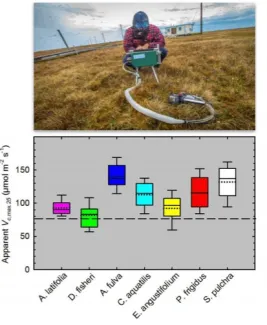Field Measurements of Photosynthetic Biochemistry Provide Improved Representation of Gas-Exchange in ESMs
Date Published
Study highlights the poor representation of Arctic photosynthesis in TBMs, and provides the critical data necessary to improve our ability to project the response of the Arctic to global environmental change.
Objective
- Measure photosynthetic CO2 response curves and leaf nitrogen (N) content in species representing the dominant vascular plant functional types found on the coastal tundra near Barrow, Alaska.
New Science
- Photosynthesis, specifically the carboxylation rate and electron transport on forbs, grasses, sedges, and shrubs, were made throughout five years.
- Traits could be assigned to plant functional types used in land surface models (e.g. ALM).
Impact
- Provides the first dataset on photosynthetic capacity for understanding physiology of cold-adapted species in the Arctic.
- Photosynthesis is inadequately described due to a low leaf nitrogen content and the fraction of that nitrogen partitioned to Rubisco.
- Productivity is underestimated in this globally important and climatically-sensitive biome.
Citation(s)
Text
Rogers, A, SP Serbin, KS Ely, VL Sloan, and SD Wullschleger. 2017. Terrestrial biosphere models underestimate photosynthetic capacity and CO2 assimilation in the Arctic. The New phytologist, 216(4):1090–1103. https://doi.org/10.1111/nph.14740
Funding
This research was supported by the Director, Office of Science, Office of Biological and Environmental Research of the US Department of Energy under Contract No. DE-AC02-05CH11231 as part of the Next-Generation Ecosystem Experiments (NGEE Arctic) project.
For more information, please contact:
Alistair Rogers
arogers@bnl.gov

